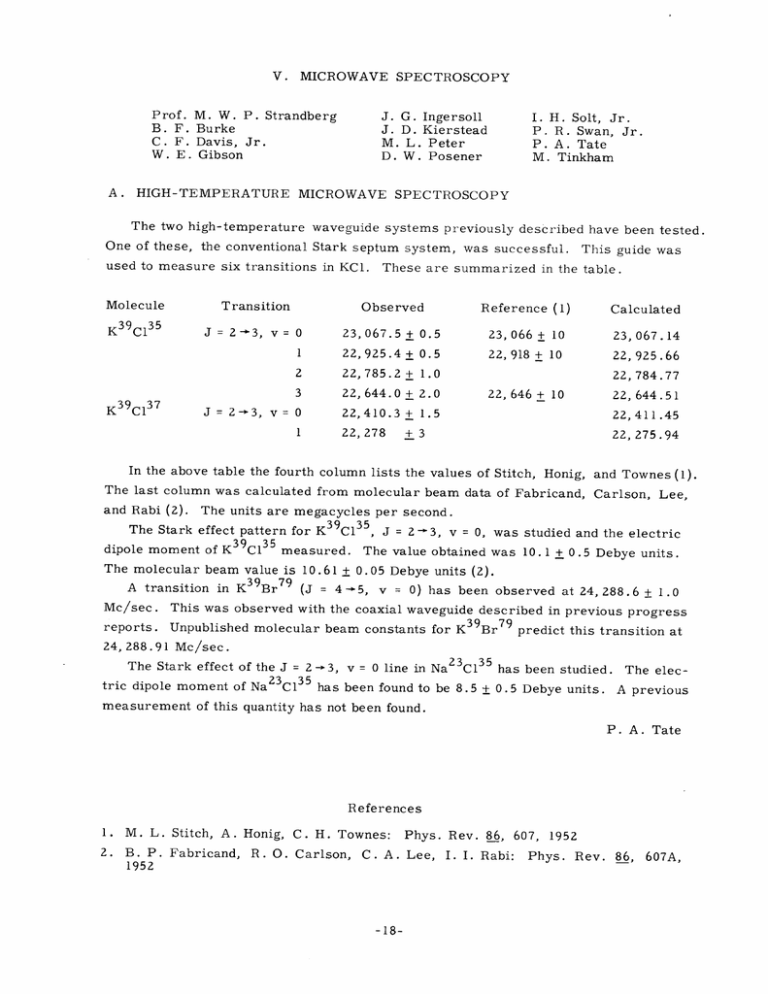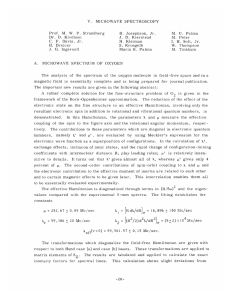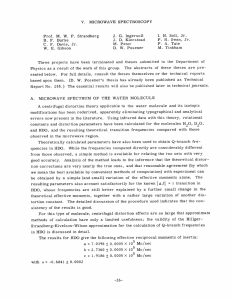J. G. Ingersoll
advertisement

V. Prof. B. F. C. F. W. E. A. MICROWAVE M. W. P. Strandberg Burke Davis, Jr. Gibson HIGH-TEMPERATURE SPECTROSCOPY J. G. Ingersoll I. H. Solt, Jr. P. R. Swan, Jr. P. A. Tate M. Tinkham J. D. Kierstead M. L. Peter D. W. Posener MICROWAVE SPECTROSCOPY The two high-temperature waveguide systems previously described have been tested. One of these, the conventional Stark septum system, was successful. This guide was used to measure six transitions in KCI. Molecule K K 39 39 C1 C 35 Transition J = 2-3, K 39 C1 3 J = 2- Observed Reference (1) Calculated 23,067.5 + 0.5 23, 066 + 10 23, 067.14 1 22,925.4+ 22, 918 + 10 22, 925.66 2 22,785.2 + 1.0 3 22,644.0 + 2.0 v = 0 37 3, These are summarized in the table. v = 0 22,410.3+ 22, 278 0.5 22, 784.77 22, 646 + 10 22, 644.51 1.5 22,411.45 + 3 22, 275.94 In the above table the fourth column lists the values of Stitch, Honig, and Townes (1). The last column was calculated from molecular beam data of Fabricand, Carlson, Lee, and Rabi (2). The units are megacycles per second. The Stark effect pattern for K39C1 3 5 , J = 2 -3, 9 dipole moment of K3 C1 35 measured. v = 0, was studied and the electric The value obtained was 10.1 + 0.5 Debye units. The molecular beam value is 10.61 + 0.05 Debye units (2). A transition in K 3 9 Br 7 9 (J = 4- 5, v = 0) has been observed at 24, 288.6 + 1.0 Mc/sec. This was observed with the coaxial waveguide described in previous progress reports. Unpublished molecular beam constants for K 3 9 Br 7 9 predict this transition at 24,288.91 Mc/sec. The Stark effect of the J = 2 -3, tric dipole moment of Na 23 C1 35 v = 0 line in Na23C135 has been studied. has been found to be 8.5 + 0.5 Debye units. The elecA previous measurement of this quantity has not been found. P. A. Tate References M. L. Stitch, A. Honig, C. H. Townes: Phys. Rev. 86, 607, 1952 B. P. Fabricand, R. O. Carlson, C. A. Lee, I. I. Rabi: Phys. Rev. 86, 1952 -18- 607A, (V. B. I lines of methyl iodide CH3 127 have been remeasured, and the quadru- Previous measurements (W. Gordy, J. pole coupling constant checked. A. G. Smith: SPECTROSCOPY) FINE STRUCTURE QUADRUPOLE The J = 1 -2 MICROWAVE 243, Phys. Rev. 7_4, W. Simmons, 1948) had shown internal inconsistency, larly in the frequency differences between the pairs of lines 3/2 -3/2, particu- 3/2 -5/2, Since both frequency differences determine the J = 1, F = 5/2 - 3/2 level spacing, they should be the same, within experimental error. The line measure5/2 - 3/2, 5/2 -5/2. ments of Gordy et al. yield the frequency differences respectively, a difference of 0.18 Mc/sec. to lie lower, 273.57 and 273.75 Mc/sec, The remeasured values, given below, seem in general, than those of reference 1, and although the quadrupole coupling constant eqQ is unchanged and a few small but unexplained discrepancies exist, the agreement of level spacing with the second-order theory is much improved. J = -- 2,, eqQ = - 1934.01 + 0.10 Frequency (Mc/sec) F -F' 1/2 30,121.11 3/2- 3/2 29,872.40 3/2 -5/2 29, 598.68 5/2 -3/2 30, 453.38 5/2 -5/2 30, 179.68 5/2 -7/2 30,079.65 7/2 -5/2 29,773.90 7/2 -7/2 29,673.87 7/2 -9/2 30,046.89 3/2 B. F. Burke C. PARAMAGNETIC RESONANCE IN OXYGEN GAS Preliminary calculations of the theoretical Zeeman splittings of the rotational levels have been made. The method has been to compute matrix components in a Hund case (a) representation, transform them to the representation which diagonalizes the fieldfree Hamiltonian, and then carry out an approximate solution of the resulting fielddependent secular equation by the continued-fraction method. This program has been carried out at external fields of 4, 8, and 12 kilogauss for essentially all M values allowed for J = K + 1 and K - 1, with the rotational quantum number K taking on all odd values up to 13. The resulting energies have been plotted, and fields giving energy dif- ferences corresponding to transitions at 3000 or 9400 Mc/sec have been located by -19- (V. MICROWAVE SPECTROSCOPY) graphical interpolation to a precision of approximately ± 100 gauss. This has allowed tentative identification of the lines observed by Beringer and Castle at 9400 Mc/sec and of those which we have observed in preliminary measurements at 3000 Mc/sec. However, secure identification must wait upon more precise calculations made to locate each individual line. We have calculated the relative intensities for a number of lines, and in general they check satisfactorily with experimental observations. Perhaps the most striking aspect of our identification is that the majority of the lines observed at 9400 Mc/sec are transitions which would be forbidden at zero magnetic field. In these cases, the two levels involved come from the splitting of the J = K + 1 and J = K - 1 levels of the rotational triplet, respectively, but the magnetic field breaks down the validity of J as a quantum number. The degree of breakdown of J increases with field, giving intensities comparable with the normally allowed transitions for fields above 6 kilogauss. Further calculations are now being made. M. Tinkham -20-




